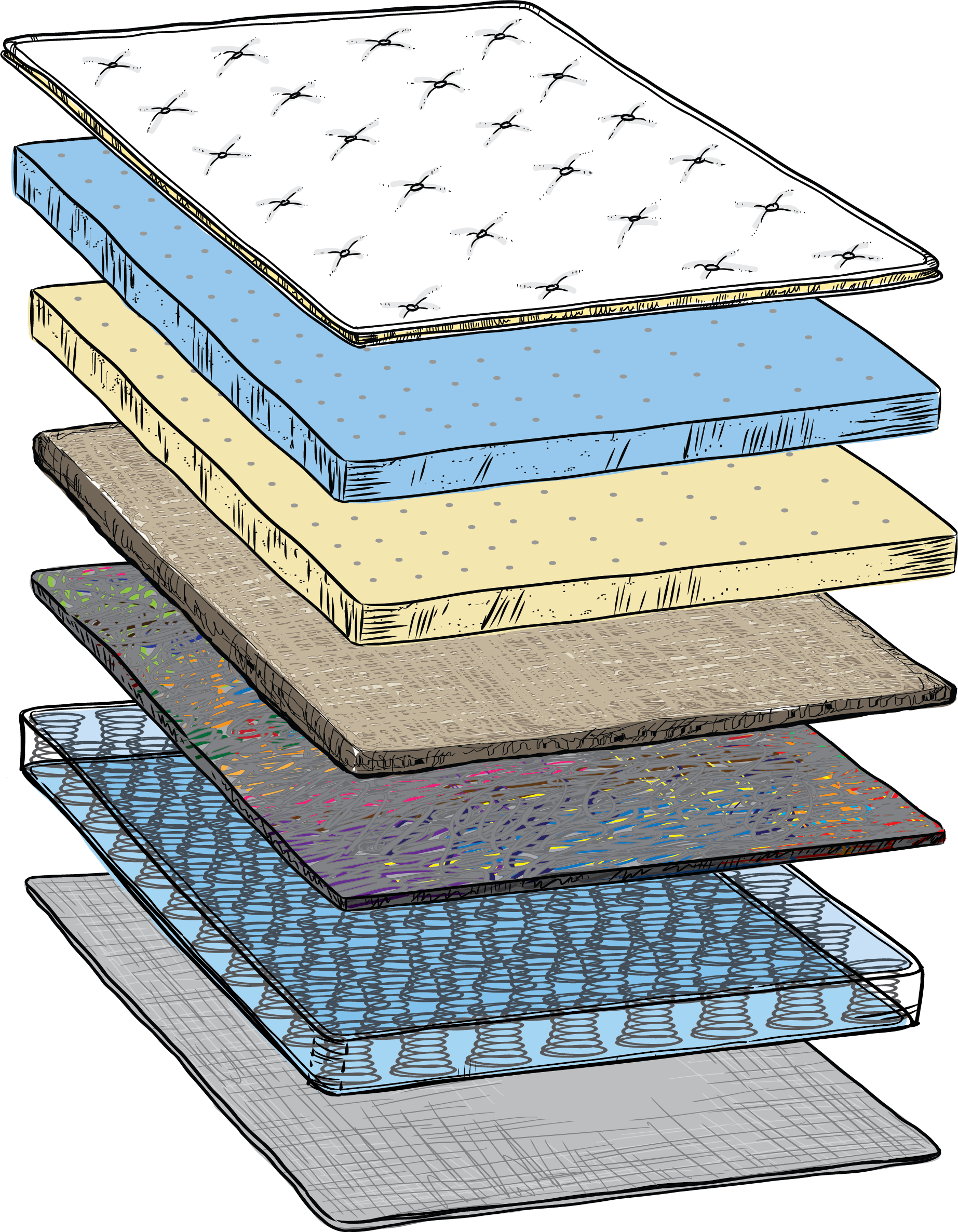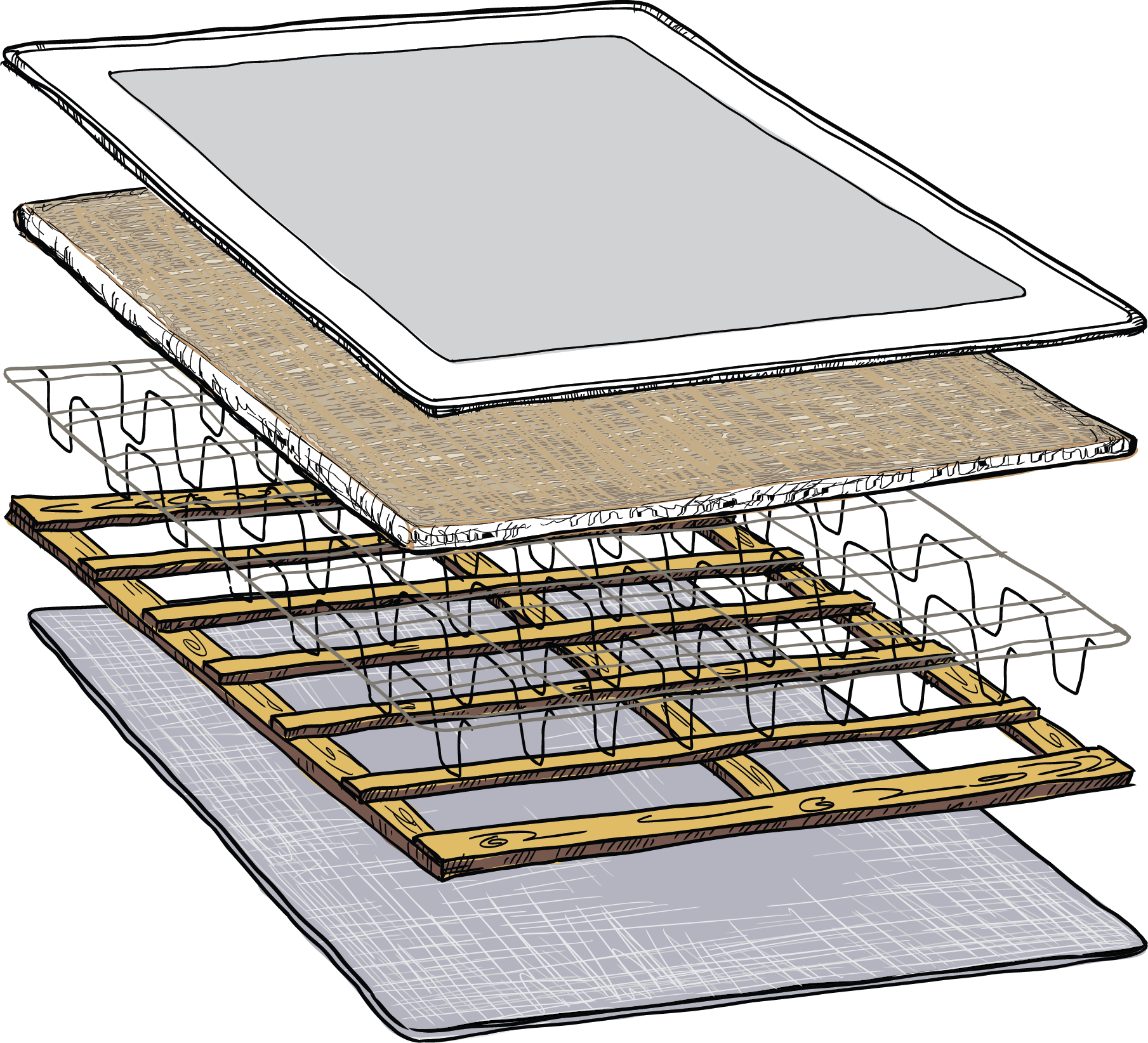Why Recycle
Mattress Recycling Makes a Difference
More than 75 percent of a mattress can be recycled into other products, diverting valuable resources from local landfills. More than 50,000 mattresses are discarded in the U.S. every day. You can make a difference.



Why Recycle:
- Less reliance on incinerators and landfills by diverting mattresses from the waste stream.
- Reduce the number of illegally dumped mattresses.
- Conservation of resources by using old steel, foam, wood and other material to create new products. This saves water, conserves energy and reduces greenhouse gas emissions.
- Recycling creates jobs.
Recycled Mattresses Contain Valuable Materials
Explore how mattress and foundation components can be recycled
into new consumer and industrial products
Mattresses

Click on a component to learn more.
Quilt Panels
- Composition: The outermost decorative layer of a quilt panel is the “ticking” which may be constructed from different kinds of fibers, including cotton, rayon, polyester, etc. The ticking is often quilted or otherwise attached to layers of other materials, including foam, cotton, polyester fiber or other fabrics.
- Current re-use: Shredded and used as a component in carpet padding.
- Challenges: Multi-layered construction that contains different material types. Visually contaminated quilt is commonly landfilled.
Memory foam
- Composition: A type of polyurethane foam layer commonly found in newer construction mattresses
- Current re-use: Shredded and blended into carpet padding
- Challenges: Memory foam has unique physical properties and are by design, less resilient than other polyurethane foams. Some carpet padding manufacturers consider memory foam to be a contaminant when blended with other materials, however some carpet pad is constructed from 100% memory foam.
Polyurethane foam
- Composition: Polyurethane is the most common type of mattress foam
- Current re-use: Shredded and blended into carpet padding
- Challenges: Clean polyurethane foam is highly valued by carpet padding manufacturers where post-consumer mattress foam is blended with post-industrial scrap foam.
or Latex Foam
- Composition: Latex foam is produced from natural latex rubber, synthetic or a blend of both
- Current re-use: Shredded and blended into carpet padding
- Challenges: Natural, synthetic and blended latex foams are not visually distinguishable. Some scrap foam buyers consider latex foam to be a contaminant and a fire hazard at higher temperatures.
Fibers
- Composition: Resilient mattress layers that may consist of coconut fibers, polyester, wool, horsehair or other materials
- Current re-use: Limited uses, typically landfilled
- Challenges: Limited volumes of these materials make accumulating a sufficient amount difficult to market to potential buyers.
or Cotton
-
- Composition: Gin mote cotton is a byproduct of the cotton industry. These are short cotton fibers that may be attached to very small seeds or stems
- Current re-use: Limited use, currently blended with other materials into insulation products
- Challenges: Limited end markets
Shoddy Felt
- Composition: A common barrier layer separating coils from foam comfort layers. Constructed of mixed post-industrial fabrics that have been shredded and bonded forming a dense felt like layer.
- Current re-use: Limited applications
- Challenges: Shoddy felt has already been recycled once. The short fiber construction and mixed composition limits use in secondary markets.
Pocketed Coils
- Composition: Individual high carbon steel coil springs, typically encased in polypropylene fabric sleeve
- Current re-use: When mechanically separated, strong market exists for scrap ferrous steel and polypropylene
- Challenges: Must separate the steel from the polypropylene using shredders or other means
or Bonnell Coils
- Composition: Hourglass shaped continuous coil layer; common in older construction mattresses. The metal is very hard and has a high carbon content.
- Current re-use: Strong markets exists for scrap ferrous steel
- Challenges: High value for steel is only achieved when shredded or compressed per secondary market buyer specifications.
Bottom layer
- Composition: Flippable mattress will have same construction as the top quilt panel. Single sided mattresses may have cotton, polyester or mixed woven ticking as the bottom layer
- Current re-use: Limited, some blended into carpet padding
- Challenges: There are few markets for textiles
Foundations

Click on a component to learn more.
Top Layer
- Composition: The top layer is typically a woven decorative fabric constructed of cotton, polyester or a blend of fibers that is quilted together with a resilient layer to isolate and protect the mattress from the wood foundation structure.
- Current re-use: Limited use, some may be shredded and blended into carpet padding applications
- Challenges: Lack consistent materials; few markets for textiles.
Shoddy Felt
- Composition: A common barrier layer separating coils from foam comfort layers. Constructed of mixed post-industrial fabrics that have been shredded and bonded forming a dense felt like layer.
- Current re-use: Limited applications
- Challenges: Shoddy felt has already been recycled once. The short fiber construction and mixed composition limits use in secondary markets.
Foundation Springs
- Composition: Typically constructed of a lower hardness and lower carbon steel than mattress springs.
- Current re-use: Strong markets exists for scrap ferrous steel
- Challenges: Requires separation of steel from the wood structure. High value for steel is only achieved when shredded or compressed per secondary market buyer specifications.
Wood frame
- Composition: Constructed of soft wood, typically Canadian pine
- Current re-use: Mulch, fuel pellets, biomass fuel, reconstructed into shipping pallets
- Challenges: Must separate the wood from the steel frame. Certain markets intolerant of nails, staples or fabric contamination.
Bottom layer
- Composition: Polyester, polypropylene or similar non-woven fabric
- Current re-use: Markets exist for polyester and polypropylene if material type is known
- Challenges: Requires clean separation of fabric for resale in secondary markets